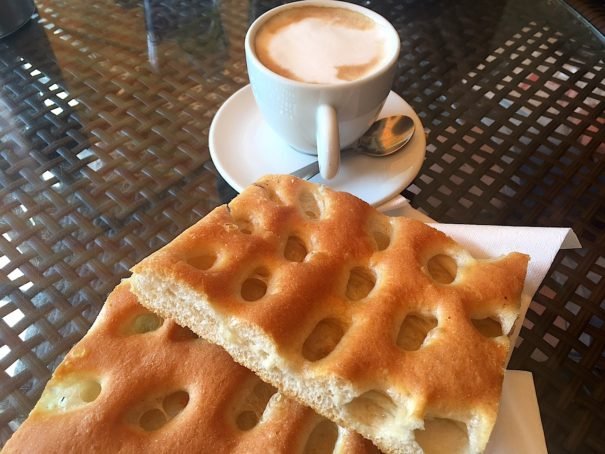
Living on the Edge and Eating a Whole Different Type of Bread for Breakfast

Living on the Edge and Eating a Whole Different Type of Bread for Breakfast
Focaccia in Monterosso
The first thing on my mind as I wake up in Monterosso, the lovely seaside village in the Cinque Terre National Park, is the trek through scenic terraced vineyards and spectacular cliffs overlooking the sea that awaits me. Breakfast, usually my first thought, is this time a close second. Then I sit at one of the outdoor tables of the café in the small square, mulling the options: should I go for the classic Italian option with an espresso and a cornetto (our croissant) or will I be tempted by some local specialty?
Then, I see the lady at the table next to me dunking a piece of plain focaccia in her cappuccino. I look again; is she a foreigner? I’m sure I heard her speaking perfect Italian. An expat, maybe? No Italian would ever drink a cappuccino with pizza (or any other savory food, with few exceptions), unless they were living abroad. Our country might be divided from North to South on multiple issues, including our regional culinary traditions, but we all agree on this. This is even truer in Naples, my home city—and most importantly, the home city of pizza margherita. I thought this delicious local focaccia—thick and soft, drizzled with extra virgin olive oil—would be no exception.
A bit surprised, I go and take a look inside: maybe they have run out of sweet options? There are plenty of pastries in there, but the counter also boasts several rows of freshly baked focaccia. When I finally decide to ask the waiter for an explanation, he says, “This is our typical breakfast, you should try it.” I hesitate. I’ve tasted fried spiders, foul-smelling fruit, and quite a lot of nose-to-tail; would I really back out of this?
I do a quick search online, and find a blog post dedicated to this local habit, explaining its pleasures to the uninitiated visitor. I discover a few things: first of all, if you really want to stick to tradition you should order a latte, but a cappuccino will do just as well; the piece of focaccia—literally, a striscia, or strip— should not be too big, so that it can fit into the cup; it should be dunked just long enough to wet the bread, but not long enough to make it mushy; finally, this breakfast requires time and attention. It’s not something you do in rush standing at the counter.
This latter point appeals to me, so I decide to give it a try. I follow the blog instructions and taste my (not too) soaked focaccia: it tastes good, not sweet nor salty or unpleasantly unbalanced, and not too oily. It actually reminds me of my childhood breakfasts, when I used to dunk the stale, rustic bread they bake in Naples—yes, bread is allowed—in a light milky coffee. I end up liking this local breakfast. I’d be happy to have it anytime I return to this part of Italy, in the same way I’d have pho for breakfast in Vietnam.